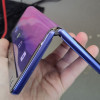Review: LG Fusic
Screen
The internal screen is very crisp, and is bright enough to use in all environments, including direct sunlight. In fact, the Fusic was easier to view outdoors than most other mid-range phones we've tested. Despite its average 176 *220 screen, we never felt like the screen was too small or wished it was QVGA. LG uses the available screen real estate well.
The external screen is large enough to read with a simple glance, and bright enough to see in all lighting conditions.
Signal
Phones with external antennas typically perform well and the Fusic is no exception. It did not lose signal except when in an absolute dead zone. Even when the signal strength indicator had no bars, as long as the operator name was visible, we were able to make a clear call. This is exactly how the Fusic passed the bank vault test.
Sound
When holding the phone to your ear in a conversation, the Fusic is plenty loud. However the external speaker for rings, speakerphone, and music playback is barely adequate. There appears to be a trend of softer external speakers among new phones- it is not just the Fusic, but most phones we've reviewed recently. However, this does not excuse the fact that in order to hear the phone ringing we had to set it to its loudest volume and turn on the vibrating alert for backup. Additionally, the speakerphone and music playback through the speaker are so soft there's no discernible difference between the external speaker and just using the earpiece speaker at maximum volume.
Battery
With normal use, the battery lasts about four days. This includes taking pictures, hopping online a few times a day, about an hour of listening to music over Bluetooth headphones, and a decent amount of calling and messaging. Add in more surfing or some video playback and battery life is reduced to about three days. That's still admirable performance for a relatively slim 3G phone.


 CTIA 2006
CTIA 2006
 LG Muziq Updates Sprint Fusic
LG Muziq Updates Sprint Fusic
 LG LX550 Launches As Fusic on Sprint
LG LX550 Launches As Fusic on Sprint
 TCL's New Foldable Concept Swings Both Ways
TCL's New Foldable Concept Swings Both Ways
 Hands On with the Motorola edge+ (2022)
Hands On with the Motorola edge+ (2022)
 LG Fusic / LX-550
LG Fusic / LX-550


